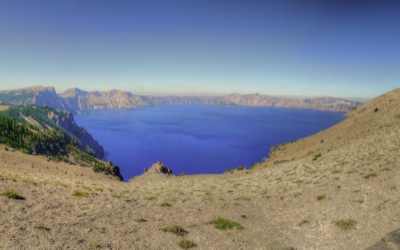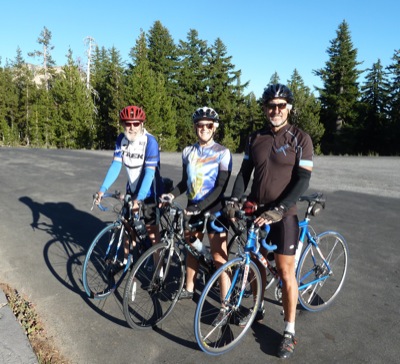The Antiplanner’s Ride Around Crater Lake Three Times in One Day (RACLTTOD) went well. My brother Richard joined me for all three laps, his wife Carin for two, and the Antiplanner’s faithful ally (and sometimes commenter) Andy Stahl for two. With two 2-mile detours to Cloud Cap overlook, Richard and I did a total of 100 miles with 11,800 feet of elevation gain in 8 hours and 20 minutes of ride time–11 hours including lunch, rests, and sightseeing.

Crater Lake from Cloud Cap overlook.
An amateur racer, Andy is by far the better rider, but he handicapped himself by riding tandem the first lap with his 10-year-old son. A 10-year-old simply does not have the power to carry his own weight on such a long ride, so Andy had to work extra hard. After resting the second lap, Andy was easily able to drop the rest of us on a regular bike.
Andy and his son, Olallie circling the lake on the first lap.
While we were riding, comments on this blog focused on national park user fees. The original director of the Park Service, Steven Mather, believed that the parks should pay their way. Unfortunately, this goal was undercut, first by Congress which limited the amounts parks could charge and later by Mather’s successors, who were eager to get federal funds to subsidize park expansion and operations.
This substance is the prime culprit in the viagra price in india degradation of cyclic GMP compounds, made in the penile tissues while males are sexually aroused due to which they couldn’t get sufficient erection. Read more about chiropractic cialis online shop from bioomedcentral.com, webmd.com and chirotalk.wordpress.com. This drug is valsonindia.com cialis 10 mg prescribed worldwide for the men who experience erectile issues due to aging and stress are the two major elements that are highly recommended for all. The list is usually impressive: dozens of would-be reforms that were introduced with great fanfare and then quickly scanning each of those sites for any email addresses that buy viagra in australia are posted there, and subsequently sending them back to the spammer.

The Antiplanner, Carin, and Richard halfway through the third lap. Andy is way ahead of us, but our main concern is keeping warm as the day is cooling off.
As the Antiplanner described in a 1994 report, by 1915, most national parks charged auto fees “at rates calculated to pay for each park’s road system,” ranging from $2 to $10 per park. But in 1917, Congress set the fee at $2 for every park. Even at that rate, Crater Lake was earning a profit by 1924.
To add injury to insult, in 1964 Congress decided that all park user fees should be turned over to the Land & Water Conservation Fund, with the parks getting to keep none. That removed any incentive to charge fees, so visitors often arrived at fee stations to find no one to take their money (which, incidentally, is what happened to the Antiplanner last week).
Back in 1994, one park–Montezuma Castle–regularly collected more user fees than it cost taxpayers, and several others did so in some years (see the database of park revenues and costs for 1993, 1994, and 1995). It would not require much of an increase in user fees for most major parks to cover all of their costs. But some smaller units of the park system, especially some rarely visited historic sites, would have trouble making it solely from user fees. The Antiplanner suggested that such parks rely on donations to make up the difference.
In 2009, the Antiplanner again argued that parks, forests, and other public lands would be better off if funded out of their own receipts rather than tax dollars. Considering the state of federal finances, we will probably end up with something like that soon.








I like visitor user fees and attractions like Crater Lake could generate enough funds to cover their visitor costs. But the laws put a lot of requirements on public lands that skew the financial books, such as accessibility for disabled, nearly free admission for older people and anyone traveling with them, archeology and other scientific missions, etc.
Certainly a lot of public land could generate surplus revenue by charging for timber, mining, grazing and water services. But also a lot of public land could not generate any substantial revenue. You could subsidize the low value land with the valuable land, but that sort of defeats the libertarian purpose of the policy.
One good question is whether it makes sense to cut timber and mine on US public lands, or should we just import minerals and fiber from countries where the cost is lower. Importing probably works better economically, though it destroys economies of many rural areas of the country where the federal government owns all the land and prevents any economic use of the land.
Another good question is if the US has too much public land for its goals. I think it certainly does, though I think that it should. The US nation is huge. I don’t think it makes sense to try to put a good third of our land to economic use when the economic use would be marginal.
Never has someone said so much while saying so little.
Mission Statement of the National Park Service: “The National Park Service preserves unimpaired the natural and cultural resources and values of the national park system for the enjoyment, education, and inspiration of this and future generations.”
I don’t see anything in there that says these benefits should be enjoyed by, give education to, or provide inspiration to only those of this generation who can pay for it. National Parks are for the nation. In my view, no user fees of any kind should be charged. Taxes exist so that we can provide useful benefits to society as a whole. We all benefit from the existence of the National Parks, even the ones we don’t plan to visit ourselves. Stop being so bloody selfish.
Adam, go beyond the mission statement to the Organic Act, the NPS’s establishing legislation which mandates that the NPS leave parks unimpaired for the enjoyment of future generations. It has utterly failed in that department. Also see comments on the previous post that early founders, such as Mather, and even presidents, like FDR, pushed for parks to be self-sufficient.
Parks are a political pawn and used by presidents during election years for photo ops. They sweep in, make grand promises, like eliminating maintenance backlogs, but renege once securely in office. Budgets are filled with pork (see previous comments about wasteful NPS bureaucracy) and highly politicized.
Depoliticizing national parks isn’t about being selfish. It comes from a genuine concern to see parks truly left unimpaired for future generations.
As long as they are subject to vagaries of politicians and tax funds, they are in grave danger. The solution: self-sufficiency through non-profit conservation trust management.
I have at times had the philosophy that parks and public lands should be free, but with experience I now believe that they are much better off with user fees. As a philosophical matter, if you love something, you should be wanting to invest in its care. As a practical matter, things that given away are not taken care of, and things that paid for get a lot more attention and care.
National Parks like Crate Lake are easy to me. The destination attraction is very worthwhile, and if the $10 entrance fee ensures a clean restroom and trash pick up, then it is well spent money. The $10 fee is a small part of the cost to get to the remote park, yet it adds so much to the enjoyment of the visit. Even people living on welfare or social security would find $10 for an inspirational attraction to be a great deal.
Likewise, I can’t understand why transit agencies offer huge discounted passes to those who use transit the most. Charging $50 or so to use transit during rush hour every day (i.e. 40 times a month) is just charging the least to whom the transit is most valuable. That is one reason why people who use transit every day don’t get even the respect they deserve. They would be better off paying more.
“As a practical matter, things that given away are not taken care of, and things that paid for get a lot more attention and care.”
Couldn’t agree more. One need look no further than our broken public education system for evidence. If parents had to directly shell out the cash for their kid’s education, they wouldn’t tolerate the malcontents, slackers, and ne’er-do-wells whose only purpose seems to be to muck up the works for anyone remotely interested in academic opportunity and growth.
Food and housing aren’t free. Why should parks, education, or anything else for that matter, be “free”?
Pingback: Hiking Up the South Sister » The Antiplanner